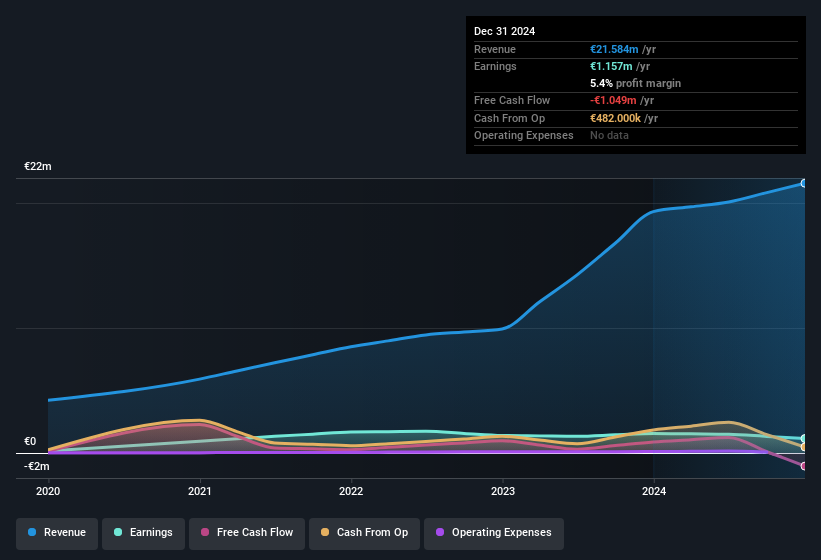Weak Statutory Earnings May Not Tell The Whole Story For IDNTT (BIT:IDNTT)
Despite IDNTT SA's (BIT:IDNTT) recent earnings report having lackluster headline numbers, the market responded positively. Sometimes, shareholders are willing to ignore soft numbers with the hope that they will improve, but our analysis suggests this is unlikely for IDNTT.
Our free stock report includes 3 warning signs investors should be aware of before investing in IDNTT. Read for free now.
A Closer Look At IDNTT's Earnings
As finance nerds would already know, the accrual ratio from cashflow is a key measure for assessing how well a company's free cash flow (FCF) matches its profit. To get the accrual ratio we first subtract FCF from profit for a period, and then divide that number by the average operating assets for the period. You could think of the accrual ratio from cashflow as the 'non-FCF profit ratio'.
As a result, a negative accrual ratio is a positive for the company, and a positive accrual ratio is a negative. While having an accrual ratio above zero is of little concern, we do think it's worth noting when a company has a relatively high accrual ratio. To quote a 2014 paper by Lewellen and Resutek, "firms with higher accruals tend to be less profitable in the future".
IDNTT has an accrual ratio of 0.29 for the year to December 2024. We can therefore deduce that its free cash flow fell well short of covering its statutory profit, suggesting we might want to think twice before putting a lot of weight on the latter. Even though it reported a profit of €1.16m, a look at free cash flow indicates it actually burnt through €1.0m in the last year. It's worth noting that IDNTT generated positive FCF of €882k a year ago, so at least they've done it in the past.
That might leave you wondering what analysts are forecasting in terms of future profitability. Luckily, you can click here to see an interactive graph depicting future profitability, based on their estimates.
Our Take On IDNTT's Profit Performance
IDNTT didn't convert much of its profit to free cash flow in the last year, which some investors may consider rather suboptimal. Because of this, we think that it may be that IDNTT's statutory profits are better than its underlying earnings power. The good news is that, its earnings per share increased by 12% in the last year. The goal of this article has been to assess how well we can rely on the statutory earnings to reflect the company's potential, but there is plenty more to consider. If you'd like to know more about IDNTT as a business, it's important to be aware of any risks it's facing. For instance, we've identified 3 warning signs for IDNTT (1 makes us a bit uncomfortable) you should be familiar with.
Today we've zoomed in on a single data point to better understand the nature of IDNTT's profit. But there are plenty of other ways to inform your opinion of a company. Some people consider a high return on equity to be a good sign of a quality business. While it might take a little research on your behalf, you may find this free collection of companies boasting high return on equity, or this list of stocks with significant insider holdings to be useful.
New: AI Stock Screener & Alerts
Our new AI Stock Screener scans the market every day to uncover opportunities.
• Dividend Powerhouses (3%+ Yield)
• Undervalued Small Caps with Insider Buying
• High growth Tech and AI Companies
Or build your own from over 50 metrics.
Have feedback on this article? Concerned about the content? Get in touch with us directly. Alternatively, email editorial-team (at) simplywallst.com.
This article by Simply Wall St is general in nature. We provide commentary based on historical data and analyst forecasts only using an unbiased methodology and our articles are not intended to be financial advice. It does not constitute a recommendation to buy or sell any stock, and does not take account of your objectives, or your financial situation. We aim to bring you long-term focused analysis driven by fundamental data. Note that our analysis may not factor in the latest price-sensitive company announcements or qualitative material. Simply Wall St has no position in any stocks mentioned.
About BIT:IDNTT
IDNTT
Engages in the production of digital omnichannel contents for its clients in Italy, rest of Europe, and Switzerland.
Reasonable growth potential with adequate balance sheet.
Market Insights
Community Narratives



